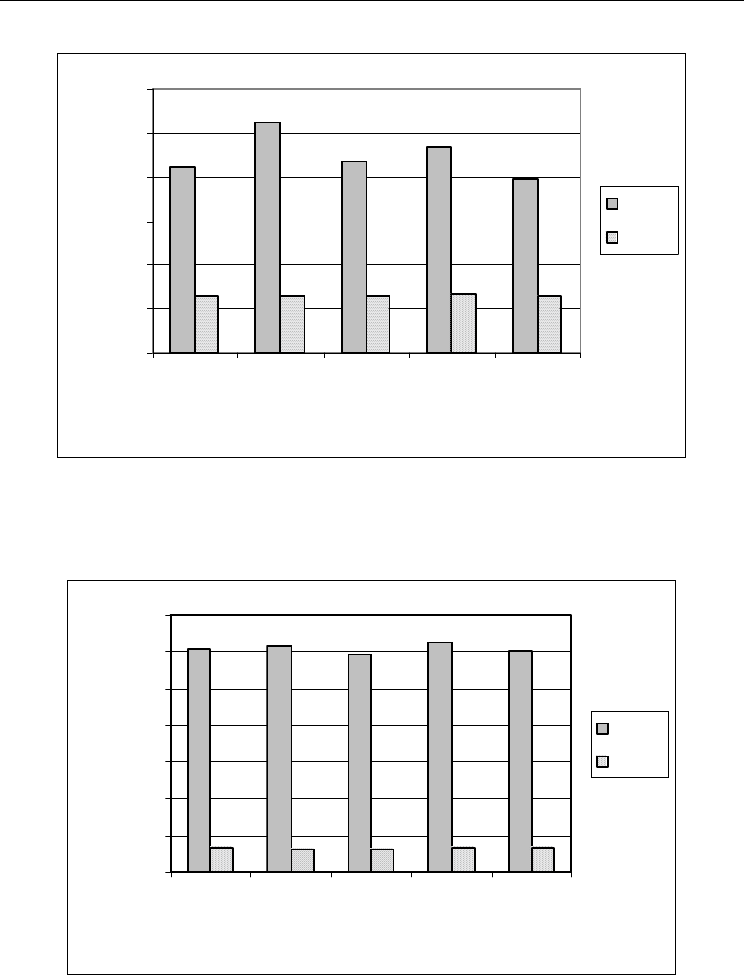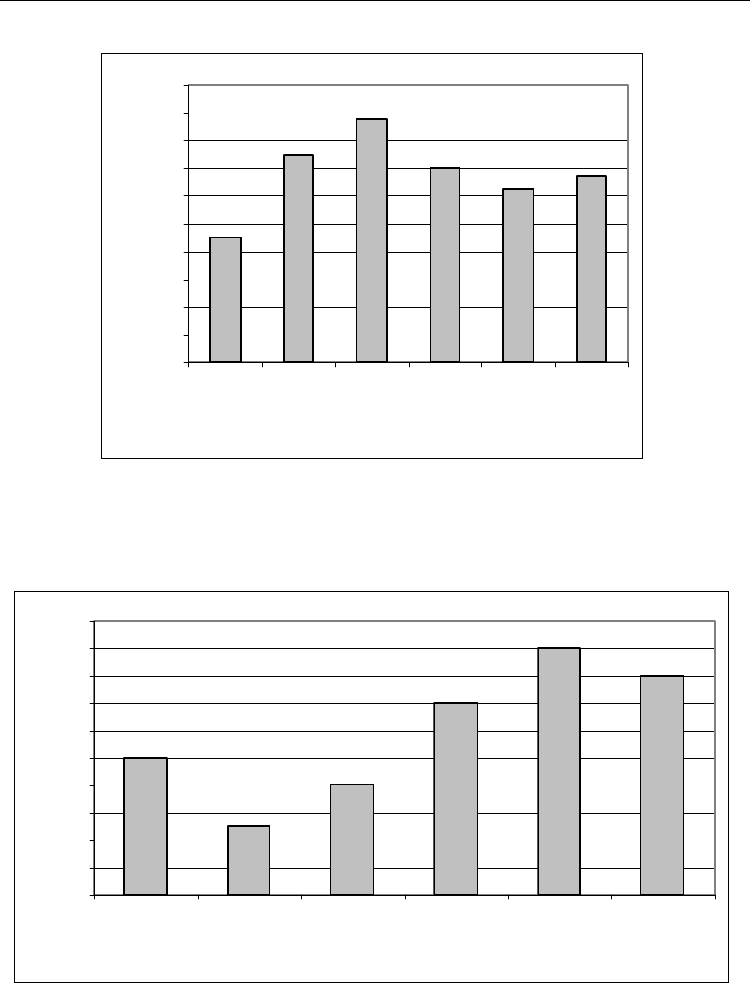Bednorz W. (ed.) Advances in Greedy Algorithms
Подождите немного. Документ загружается.


Heuristic Algorithms for Solving Bounded Diameter Minimum Spanning Tree Problem and Its
Application to Genetic Algorithm Development
381
0
10
20
30
40
50
60
12345
Index of instances
Min weight of tree
OTTC
GA2
Fig. 13. The best solution found by the OTTC and GA
2
on all the problem instance with n =
250, k = 15
0
20
40
60
80
100
120
140
12345
Index of instances
Min weight of tree
RGH1
GA3
Fig. 14. The best solution found by the RGH
1
and GA
3
on all the problem instance with n =
250, k = 15

Advances in Greedy Algorithms
382
122.4%
100%
0
50
100
150
200
250
300
350
400
450
CBRC GA 1
Algorithm
Weight of tree
0.0%
20.0%
40.0%
60.0%
80.0%
100.0%
120.0%
140.0%
Percentage
Fig. 15. Sum up the best solution found by the CBRC and GA
1
on all the problem instances
(20 instances)
481.5%
100.0%
0
200
400
600
800
1000
1200
1400
1600
1800
2000
OTTC GA 2
Algorithm
Weight of tree
0.0%
100.0%
200.0%
300.0%
400.0%
500.0%
600.0%
Percentage
Fig. 16. Sum up the best solution found by the OTTC and GA
2
on all the problem instances
(20 instances)

Heuristic Algorithms for Solving Bounded Diameter Minimum Spanning Tree Problem and Its
Application to Genetic Algorithm Development
383
1331.3%
100.0%
0
500
1000
1500
2000
2500
3000
3500
4000
4500
5000
RGH1 GA 3
Algorithm
Weight of tree
0.0%
200.0%
400.0%
600.0%
800.0%
1000.0%
1200.0%
1400.0%
Percentage
Fig. 17. Comparision between the best solution found by the RGH
1
and GA
3
on all the
problem instances (20 instances)
101.1%
101.8%
102.5%
101.9%
100.9%
100.0%
318
320
322
324
326
328
330
332
GA1 GA 2 GA 3 GA4 GA5 GA 6
Algorithm
Weight of tree
98.5%
99.0%
99.5%
100.0%
100.5%
101.0%
101.5%
102.0%
102.5%
103.0%
Percentage
Fig. 18. Comparision between the best solution found by found by GA
1
, GA
2
, GA
3
, GA
4
, GA
5
,
GA
6
on all the problem instance (20 instances)

Advances in Greedy Algorithms
384
0
0.2
0.4
0.6
0.8
1
1.2
1.4
1.6
1.8
2
GA1GA2GA3GA4GA5GA6
Algorithm
Standard deviation
Fig. 19. Comparision between the standard deviation of the solution found by GA
1
, GA
2
,
GA
3
, GA
4
, GA
5
, GA
6
on all the problem instance (20 instances)
0
2
4
6
8
10
12
14
16
18
20
GA1 GA 2 GA3 GA 4 GA 5 GA 6
Algorithm
Number of instances
Fig. 20. Number of instances found best result by GA
1
, GA
2
, GA
3
, GA
4
, GA
5
, GA
6
on all the
problem instance (20 instances)

Heuristic Algorithms for Solving Bounded Diameter Minimum Spanning Tree Problem and Its
Application to Genetic Algorithm Development
385
6. Conclusion
We have introduced the heuristic algorithm for solving BDMST problem, called CBRC. The
experiment shows that CBRC have best result than the other known heuristic algorithm for
solving BDMST prolem on Euclidean instances. The best solution found by the genetic
algorithm which uses best heuristic algorithm or only one heuristic algorithm for
initialization the population is not better than the best solution found by the genetic
algorithm which uses mixed heuristic algorithms (randomized heuristic algorithm and
greddy randomized heuristic algorithm). The solution found by the genetic algorithm which
uses mixed heuristic algorithm for initialization always is the best result.
7. References
M.R. Garey and D.S.Johnson (1979), Computers and Intractability: A Guide to the Theory of
NP-Completeness.
K. Raymond (1989), “A Tree-based Algorithm for Distributed Mutual Exclusion”, ACM
Transactions on Computer Systems, 7 (1), 1989, pp. 61-77.
K. Bala, K. Petropoulos (1993), and T. E. Stern, “Multicasting in a linear Lightwave
Network”, in Proceedings of IEEE INFOCOM’93, 1993, pp. 1350–1358
C.C. Palmer and A. Kershenbaum (1994), “Representing Trees in Genetic Algorithms”, in
Proceedings of The First IEEE Conference on Evolutionary Computation, pp. 379-
384
N.R.Achuthan, L.Caccetta, P.Caccetta, and A. Geelen (1994), “Computational Methods for
the Diameter Restricted Minimum Weight Spanning Tree Problem”, Australian
Journal of Combinatorics, 10, pp.51-71.
NA. Bookstein and S. T. Klein (1996), « Compression of Correlated Bit-Vectors”, Information
Systems, 16 (4), pp. 387-400.
G. Kortsarz and D. Peleg (1997), “Approximating Shallow-light Trees”, in Proceedings of the
8th Symposium on Discrete Algorithms, pp. 103-110.
A. Abdalla, N. Deo, and P. Gupta (2000), “Random-tree Diameter and the Diameter
Constrained MST”, in Proceedings of Congress on Numerantium, pp. 161-182.
J.Gottlieb, B.A.Julstrom, F.Rothlauf, and G.R.Raidl (2001), “Prufer Numbers: A Poor
Representation of Spanning Trees for Evolutionary Search”, in Proceedings of the
Genetic and Evolutionary Computation Conference (GECCO’2001).
A. Abdalla (2001), “Computing a Diameter-constrained Minimum Spanning Tree”, PhD
Dissertation, The School of Electrical Engineering and Computer Science,
University of Central Florida.
G.R. Raidl and B.A. Julstrom (2003), “Edge-sets: An Effective Evolutionary Coding of
Spanning Trees”, IEEE Transactions on Evolutionary Computation, 7, pp.225-239.
G.R. Raidl and B.A. Julstrom, (2003) “Greedy Heuristics and an Evolutionary Algorithm for
the Bounded-Diameter Minimum Spanning Tree Problem”, in Proceeding of the
ACM Symposium on Applied Computing, pp. 747-752.
B.A. Julstrom, G.R. Raidl (2003), “A Permutation Coded Evolutionary for the Bounded
Diameter Minimum Spanning Tree Problem, in Proceedings of the Genetic and
Evolutionary Computation Conference (GECCO’2003), pp.2-7.

Advances in Greedy Algorithms
386
B.A. Julstrom (2004), “Encoding Bounded Diameter Minimum Spanning Trees with
Permutations and Random Keys”, in Proceedings of Genetic and Evolutionary
Computational Conference (GECCO’2004).
L Gouveia, T.L. Magnanti and C. Requejo (2004), “A 2-Path Approach for Odd Diameter
Constrained Minimum Spanning and Steiner Trees”, Network, 44 (4), pp. 254-265.
M. Gruber and G.R. Raidl (2005), “A New 0-1 ILP Approach for the Bounded Diameter
Minimum Spanning Tree Problem, in Proceedings of the 2nd International
Network Optimization Conference.
M. Gruber and G.R. Raidl (2005), “Variable Neighbourhood Search for the Bounded
Diameter Minimum Spanning Tree Problem, in Proceedings of the 18th Mini Euro
Conference on Variable Neighborhood Search, Spain.
M. Gruber, J. Hemert, and G.R. Raidl (2006), “Neighbourhood Searches for the Bounded
Diameter Minimum Spanning Tree Problem Embedded in a VNS, EA and ACO”,
in Proceedings of Genetic and Evolutionary Computational Conference
(GECCO’2006).
F. Rothlauf (2006), Representations for Genetic and Evolutionary Algorithms, 2nd Edition,
Springer-Verlag.
Nguyen Duc Nghia and Huynh Thi Thanh Binh (2007), “A New Recombination Operator
for Solving Bouded Diameter Minimum Spanning Tree Problem”, in Proceedings of
RIVF’2007, LNCS.
A. Singh and A.K. Gupta (2007), “An Impoved Heuristic for the Bounded Diameter
Minimum Spanning Tree Problem, Journal of Soft Computing, 11, pp. 911-921.
G. Kortsarz and D. Peleg (1999), ”Approximating the Weight of Shallow Steiner Trees”,
Discrete Application Mathematics, 93, 1999, pp. 265-285.
R. Prim (1957), “Shortest Connection Networks and Some Generalization”, Bell System
Technical Journal, 36, pp. 1389-1401.
Huynh Thi Thanh Binh, Nguyen Xuan Hoai, R.I Ian McKay (2008a), “A New Hybrid
Genetic Algorithm for Solving the Bounded Diameter Minimum Spanning Tree
Problem”, Proceedings of IEEE World Congress on Computational Intelligence,
Hong Kong, LNCS
Huynh Thi Thanh Binh, Nguyen Xuan Hoai, R.I Ian McKay, Nguyen Duc Nghia (2008b),
“A new heuristic for the bouded diameter minimum spanning tree problem : some
preliminary results”, Conference on Artificial Intelligence PRICAI 2008, submitted
21
Opportunistic Scheduling for Next Generation
Wireless Local Area Networks
Ertuğrul Necdet Çiftçioğlu
1
and Özgür Gürbüz
2
1
The Pennsylvania State University,
2
Sabancı University,
1
USA,
2
Turkey
1. Introduction
Wireless access has been increasingly popular recently due to portability and low cost of
wireless terminals and equipment. The emerging technologies for wireless local area
networks (WLANs) are defined by the IEEE 802.11n standard, where physical layer data
rates exceeding 200 Mbps are provisioned with multiple input multiple output antenna
techniques. However, actual throughput to be experienced by WLAN users is considerably
lower than the provided physical layer data rates, despite the link efficiency is enhanced via
the frame aggregation concept of 802.11n.
In a multi user communication system, scheduling is the mechanism that determines which
user should transmit/receive data in a given time interval. Opportunistic scheduling
algorithms maximize system throughput by making use of the channel variations and multi
user diversity. The main idea is favouring users that are experiencing the most desirable
channel conditions at each scheduling instant, i.e. riding the peaks. While maximizing
capacity, such greedy algorithms may cause some users to experience unacceptable delays and
unfairness, unless the users are highly mobile. In order to remedy this problem, we combine
aggregation and opportunistic scheduling approaches to further enhance the throughput of
next generation WLANs. We argue that aggregation can dramatically change the scheduling
scenario: A user with a good channel and a long queue may offer a higher throughput than a
user with better channel conditions but shorter queue. Hence, the statement that always
selecting the user with the best channel maximizes throughput is not valid anymore.
In this work, we first present our queue aware scheduling scheme that take into account the
instantaneous channel capacities and queue sizes simultaneously, named as Aggregate
Opportunistic Scheduling (AOS). Detailed simulations results indicate that our proposed
algorithm offers significant gains in total system throughput, by up to 53%, as compared to
opportunistic schedulers while permitting relatively fair access. We also improve AOS with
the principle of relayed transmissions and show the improvements of opportunistic
relaying. Later on, we propose another scheduler, which aims to maximize the network
throughput over a long time scale. For this purpose, we estimate the statistical evolution of
queue states and model the 802.11n MAC transmissions using queuing theory by extending
the bulk service model. Utilizing the outcomes of the queuing model, we design Predictive
Scheduling with time-domain Waterfilling (P-WF) algorithm. P-WF further improves the

Advances in Greedy Algorithms
388
performance of our queue aware schedulers, as the throughput is maximized by applying
the water filling solution to time allocations.
This chapter includes an overview of existing literature on opportunistic scheduling for
wireless networks in general and presents our proposed algorithms with comparative
detailed performance analysis as they are applied into the next generation WLANs.
2. Scheduling approaches for wireless networks
In a multi user communication system scheduling is an essential feature due to its effect on
the overall behavior of the network. In this section, we briefly present the prominent
scheduling disciplines for wireless networks. In this text, the terms user and station are used
interchangeably.
2.1 Maximum Rate Scheduling (MRS) algorithm
Spatially greedy scheduling schemes, often denoted as Maximum Rate Scheduling (MRS)
exploit variations in the time varying wireless channel. The selection metric is the channel
capacity, allowing the user with the best channel conditions to transmit at a given time
instant [Knopp & Humblet, 1995]. In other words, the selected user k
i
* at the i
th
transmission
opportunity is determined as:
*
arg max
k
ii
k
kC=
,
(1)
where
k
i
C
denotes the channel capacity of the k
th
user at the i
th
transmission opportunity.
Scheduling users according to the channel state can provide significant performance gain
due to the independence of fading statistics across users. This phenomenon is called multi
user diversity. Although MRS method is shown to be optimal for capacity maximization, an
important issue is unfairness in throughput distribution between the users, since the users
subject to poor channel conditions may never get a chance to transmit.
2.2 Proportional Fair Queuing (PFQ) algorithm
In Proportional Fair Queuing (PFQ) algorithm, the user with the best channel condition
(capacity) relative to its own average capacity is selected [Jalali et al., 2000]. The main aim of
PFQ is to maximize throughput while satisfying fair resource allocation. If the users of all
channels deviate from their mean capacities in similar ways, all users will gain access to the
medium for similar proportions. Note that, being selected for similar proportions does not
imply that the users have identical temporal share, since transmission to users with low data
rates take longer time durations for the same amount of data. In PFQ, the selected user k
i
*
can be found as:
*
arg max
k
i
i
k
k
i
C
k
C
=
(2)
where
k
i
C
denotes the average channel capacity of the k
th
user up to the i
th
transmission
opportunity.
2.3 Capacity Queue Scheduler (CQS)
When the above opportunistic schemes are employed, users with high capacity links tend to
have small queues, while users subject to poor channel conditions suffer from queue

Opportunistic Scheduling for Next Generation Wireless Local Area Networks
389
overflows and long delays. In [Neely et al., 2002], a scheduler is applied which maximizes
the link rates weighted by queue backlog differentials for each link. In this downlink setting,
the queue-weighted rate metric tries to select user k
i
* as
*
arg max
kk
iii
k
kCQ=
, (3)
where
k
i
Q
denotes the queue size of the k
th
user at the i
th
transmission opportunity. The
inclusion of queue length in this scheme provides important insights for fairness. For
instance, assume initially that the queue sizes are similar for all users, except for one user
whose channel is superior to others. The user with the best channel will be selected and
served so its queue size will be reduced; however, in the next scheduling instant, the
advantage of better channel quality will be alleviated by the smaller queue size, yielding
transmission to other users. The algorithm guarantees stability whenever the arrival rate
vector lies within the stability region of the network.
2.4 Shortest Remaining Processing Time First (SRPT) algorithm
Another scheduling algorithm that considers queue size together with capacity is Shortest
Remaining Processing Time First (SRPT) method, where the metric is defined as the amount
of time it takes to serve all the packets from a given queue [Schrage & Miller, 1966]. Here,
the scheduler tries to choose the queue, which can be emptied in the shortest amount of
time, i.e., the selected user k
i
* at the i
th
transmission opportunity is determined as:
*
arg min
k
i
i
k
k
i
Q
k
C
=
. (4)
2.6 Opportunistic Autorate (OAR) algorithm
Opportunistic Autorate protocol (OAR) is an opportunistic scheduler which takes into
account the effect of aggregation, as the users are served in a round-robin fashion [Sadeghi
et al., 2002]. While serving each user, the number of packets transmitted for the user
depends on the ratio of the user rate to basic rate, hence operating with larger aggregate
sizes for users with better channel conditions. It is worthwhile to note that OAR provides
temporal fairness since the packet transmission times for each user are equal.
2.7 Longest Queue (LQ) algorithm
Longest Queue (LQ) algorithm, which is also one of the considered schemes for 802.11n
[Mujtaba, 2004], is a non-opportunistic scheduling scheme. Using LQ, the scheduler simply
selects the station with the largest number of packets in its queue and the channel states are
not taken into account. In LQ, the selected user k
i
* is found as
*
arg max
k
ii
k
kQ=
(5)
The queues of users which have not been served for a long time duration are likely to be
long, increasing the scheduling metrics and eventually causing the assocaited user to be
served. The reasoning behind the LQ algorithm is to maximize the aggregate size for
maximizing the throughput, with the basic assumption that users are experiencing similar

Advances in Greedy Algorithms
390
channels with equal data rates. However, the channel quality of stations can vary notably
due to time-varying wireless channel and mobility [Rappaport, 2002].
In all of these approaches, the scheduler operates at the physical layer, considering the
channel quality and/or queue level for the decision of the selected user. Once the user is
selected, the implicit assumption is that a single physical layer data unit is transmitted and
the link is fully utilized. With the frame aggregation feature of 802.11n, a number of packets
are combined before transmission, so that WLAN overhead is reduced and link efficiency is
improved [Tinnirello & Choi, 2005], [Liu & Stephens, 2005]. However, with aggregation, the
advantages of opportunism and the statement that selecting the user with the highest
channel capacity maximizes the throughput is not valid anymore. For instance, the MRS
algorithm with frame aggregation may starve since specific stations are to be served more
frequently, their queues will be drained, causing their aggregate sizes to be small, resulting
in low efficiency and throughput. Algorithms such as SRPT favour users with high capacity
and small queue sizes, which is even worse with frame aggregation causing low
throughput. OAR considers frame aggregation and provides temporal fairness, but does not
aim throughput maximization. When aggregation is employed, a user with a fair channel
and long queue may result in a much higher throughput than a user with a high capacity
channel but small queue size. In this work, we study all of the aforementioned algorithms
with frame aggregation in the setting of next generation IEEE 802.11n WLANs. We also
propose new scheduling algorithms that aim to enhance the performance and fill the
performance gap between available and observed data rates by jointly considering channel
and queue states of users via throughput calculations.
3. System model
We consider the downlink of a Multiple Input Multiple Output (MIMO) [Telatar, 1999]
wireless cellular system that consists of a single access point (AP) communicating with
multiple WLAN clients (Figure 1). The system is a closed-loop MIMO OFDM system such that
the mobile users measure their channel states and send them as feedback to the AP. Based on
the channel state, link capacities are calculated and 802.11n data rates are assigned at the AP
according to available capacity
1
. The properties of the fading wireless channel are modeled in
the channel matrix H, considering large-scale path loss, shadowing and small scale multi-path
fading affects. In this paper, the log distance path loss model and the Channel B fading
channel model defined by the Task Group n (TGn) are considered. The fading characteristics
between individual antenna pairs are spatially correlated and the correlation matrices depend
on the angular spread. Further details of the channel model can be found in [Erceg et al., 2004].
Due to low speeds of WLAN users, coherence time is large enough so that channel fading is
slow, i.e. the channel is assumed stationary within one transmission opportunity.
1
In MIMO-OFDM based systems, the channel capacity is calculated by partitioning the
system into multiple sub-channels that correspond to different sub-carriers as follows
[Bolcskei et al., 2002]: C=
1
22
2
0
log (det( ( ) ( )))
c
cc
c
kk
N
jj
NN
H
MN
k
c
B
ee
N
ππ
ρ
−
=
+
∑
IH H
, with
2
()
j
e
π
θ
H
=
1
2
0
L
j
l
l
l
e
π
θ
−
−
=
∑
H
(N
c
: Number of subcarriers). The capacity calculation here considers the air interface
specified in 802.11n draft standard. However, the scheduling algorithms can be applied to
any other air interface with appropriate capacity calculations.
